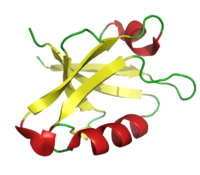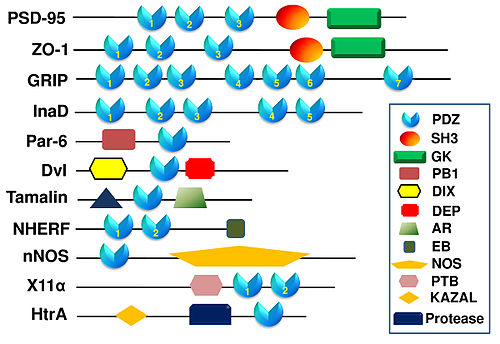- PDZ domain
-

Molecular structure of the PDZ domain included in the human GOPC (Golgi-associated PDZ and coiled-coil motif-containing protein) protein Identifiers Symbol PDZ Pfam PF00595 InterPro IPR001478 SMART PDZ PROSITE PDOC50106 SCOP 1lcy Available protein structures: Pfam structures PDB RCSB PDB; PDBe PDBsum structure summary The PDZ domain is a common structural domain of 80-90 amino-acids found in the signaling proteins of bacteria, yeast, plants, viruses[1] and animals.[2] PDZ is an acronym combining the first letters of three proteins — post synaptic density protein (PSD95), Drosophila disc large tumor suppressor (Dlg1), and zonula occludens-1 protein (zo-1) — which were first discovered to share the domain[3]. PDZ domains have previously been referred to as DHR (Dlg homologous region)[4] or GLGF (glycine-leucine-glycine-phenylalanine) domains [5]. These domains help anchor transmembrane proteins to the cytoskeleton and hold together signaling complexes[6].
In general PDZ domains bind to a short region of the C-terminus of other specific proteins. These short regions bind to the PDZ domain by beta sheet augmentation. This means that the beta sheet in the PDZ domain is extended by the addition of a further beta strand from the tail of the binding partner protein.[7]
Contents
Proteins containing this domain
 Examples of PDZ domain-containing proteins (Figure from Lee et al. 2010).[8] Proteins are indicated by black lines scaled to the length of the primary sequence of the protein.
Examples of PDZ domain-containing proteins (Figure from Lee et al. 2010).[8] Proteins are indicated by black lines scaled to the length of the primary sequence of the protein.
PDZ domains are found in many thousands of known proteins. PDZ domain proteins are widespread in eukaryotes and eubacteria,[2] whereas there are very few examples of the protein in archaebacteria. PDZ domains are often associated with other protein domains and these combinations allow them to carry out their specific functions. For example the PDZ domains in the PSD-95 protein are found associated with an SH3 domain and a guanylate kinase domain.
Human
There are roughly 260 human PDZ domains, though since several PDZ domain-containing proteins hold several domains, the actual number of PDZ proteins is closer to 180. Listed below are some of the better studied members of this family:
- Cystic fibrosis transmembrane conductance regulator [9] (CFTR)
- Erbin
- Htra1
- Htra2
- Htra3
- PSD-95
- SAP97
- CARD11
- PTP-BL[10]
Below is a complete list:
AAG12; AHNAK; AHNAK2; AIP1; ALP; APBA1; APBA2; APBA3; ARHGAP21; ARHGAP23; ARHGEF11; ARHGEF12; CASK; CLP-36; CNKSR2; CNKSR3; DFNB31; DLG1; DLG2; DLG3; DLG4; DLG5; DVL1; DVL1L1; DVL2; DVL3; ERBB2IP; FRMPD1; FRMPD2; FRMPD2L1; FRMPD3; FRMPD4; GIPC1; GIPC2; GIPC3; GOPC; GRASP; GRIP1; GRIP2; HTRA1; HTRA2; HTRA3; HTRA4; IL16; INADL; KIAA1849; LDB3; LIMK1; LIMK2; LIN7A; LIN7B; LIN7C; LMO7; LNX1; LNX2; LRRC7; MAGI1; MAGI2; MAGI3; MAGIX; MAST1; MAST2; MAST3; MAST4; MCSP; MLLT4; MPDZ; MPP1; MPP2; MPP3; MPP4; MPP5; MPP6; MPP7; MYO18A; ;NOS1; PARD3; PARD3B; PARD6A; PARD6B; PARD6G; PDLIM1; PDLIM2; PDLIM3; PDLIM4; PDLIM5; PDLIM7; PDZD11; PDZD2; PDZD3; PDZD4; PDZD5A; PDZD7; PDZD8; PDZK1; PDZRN3; PDZRN4; PICK1; PPP1R9A; PPP1R9B; PREX1; PRX; PSCDBP; PTPN13; PTPN3; PTPN4; RAPGEF2; RAPGEF6; RGS12; RGS3; RHPN1; RIL; RIMS1; RIMS2; SCN5A; SCRIB; SDCBP; SDCBP2; SHANK1; SHANK2; SHANK3; SHROOM2; SHROOM3; SHROOM4; SIPA1; SIPA1L1; SIPA1L2; SIPA1L3; SLC9A3R1; SLC9A3R2; SNTA1; SNTB1; SNTB2; SNTG1; SNTG2; SNX27; SPAL2; STXBP4; SYNJ2BP; SYNPO2; SYNPO2L; TAX1BP3; TIAM1; TIAM2; TJP1; TJP2; TJP3; TRPC4; TRPC5; USH1C; WHRN;
Virus
Tax1
References
- ^ Boxus M, Twizere JC, Legros S, Dewulf JF, Kettmann R, Willems L (2008). "The HTLV-1 Tax interactome". Retrovirology 5: 76. doi:10.1186/1742-4690-5-76. PMC 2533353. PMID 18702816. http://www.pubmedcentral.nih.gov/articlerender.fcgi?tool=pmcentrez&artid=2533353.
- ^ a b Ponting CP (February 1997). "Evidence for PDZ domains in bacteria, yeast, and plants". Protein Sci. 6 (2): 464–468. doi:10.1002/pro.5560060225. PMC 2143646. PMID 9041651. http://www.pubmedcentral.nih.gov/articlerender.fcgi?tool=pmcentrez&artid=2143646.
- ^ Kennedy MB (September 1995). "Origin of PDZ(DHR,GLGF) domains". Trends Biochem. Sci. 20 (9): 350. doi:S0968-0004(00)89074-X. PMID 77482701.
- ^ Ponting CP, Phillips C (March 1995). "DHR domains in syntrophins, neuronal NO synthases and other intracellular proteins". Trends Biochem. Sci. 20 (3): 102–103. doi:10.1016/S0968-0004(00)88973-2. PMID 7535955.
- ^ Cho KO, Hunt CA, Kennedy MB (Nov 1992). "The rat brain postsynaptic density fraction contains a homolog of the Drosophila discs-large tumor suppressor protein". Neuron 9 (5): 929–42. doi:10.1016/0896-6273(92)90245-9. PMID 1419001.
- ^ Ranganathan R, Ross E (1997). "PDZ domain proteins: scaffolds for signaling complexes". Curr Biol 7 (12): R770–R773. doi:10.1016/S0960-9822(06)00401-5. PMID 9382826.
- ^ Cowburn D (December 1997). "Peptide recognition by PTB and PDZ domains". Curr. Opin. Struct. Biol. 7 (6): 835–838. doi:10.1016/S0959-440X(97)80155-8. PMID 9434904.
- ^ Lee HJ, Zheng JJ (2010). "PDZ domains and their binding partners: structure, specificity, and modification". Cell Commun. Signal 8: 8. doi:10.1186/1478-811X-8-8. PMC 2891790. PMID 20509869. http://www.pubmedcentral.nih.gov/articlerender.fcgi?tool=pmcentrez&artid=2891790.
- ^ Short DB, Trotter KW, Reczek D et al. (July 1998). "An apical PDZ protein anchors the cystic fibrosis transmembrane conductance regulator to the cytoskeleton". J. Biol. Chem. 273 (31): 19797–19801. doi:10.1074/jbc.273.31.19797. PMID 9677412.
- ^ Jemth P, Gianni S (July 2007). "PDZ domains: folding and binding". Biochemistry 46 (30): 8701–8708. doi:10.1021/bi7008618. PMID 17620015.
Further reading
- Ponting CP, Phillips C, Davies KE, Blake DJ (June 1997). "PDZ domains: targeting signalling molecules to sub-membranous sites". Bioessays 19 (6): 469–479. doi:10.1002/bies.950190606. PMID 9204764.
- Doyle DA, Lee A, Lewis J, Kim E, Sheng M, MacKinnon R (June 1996). "Crystal structures of a complexed and peptide-free membrane protein-binding domain: molecular basis of peptide recognition by PDZ". Cell 85 (7): 1067–1076. doi:10.1016/S0092-8674(00)81307-0. PMID 8674113.
External links
- Eukaryotic Linear Motif resource motif class LIG_PDZ_Class_1
- Eukaryotic Linear Motif resource motif class LIG_PDZ_Class_2
- Eukaryotic Linear Motif resource motif class LIG_PDZ_Class_3
- The PDZ Domain as a Complex Adaptive System A concise technical summary and a statement of principle findings and ramifications of the PDZ Domain as a Complex Adaptive System
- NCBI conserved domains entry
Protein domains Categories:- Protein domains
- Membrane proteins
Wikimedia Foundation. 2010.
